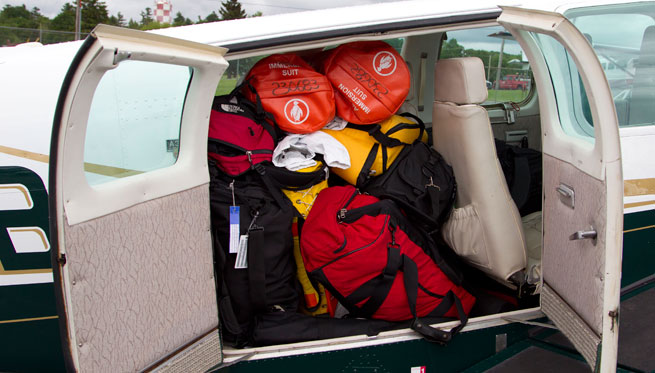Ownership: Traveling by GA
Making the best mode of transportation even better

Regardless of what form of transportation you use to get where you’re going, traveling by its nature is challenging and inconvenient. We humans have a lot of stuff, and when we are forced to condense it down to a bag or two, it’s not easy—even for an experienced traveler. I have come to the realization that I will never be a toothbrush-underwear-and-credit-card-only kind of traveler—and the 80 pounds of camera gear that accompanies me by default assures this. However, experience (read a whole lots mistakes) has produced some tips that might make your next general aviation trip a bit more pleasant.
Packing. Unless you have an airstair with more than three steps, pack your bulky hard-sided luggage with ugly Christmas sweaters and give it to Goodwill—soft luggage such as duffels, garment bags, and backpacks are the way to go. AOPA Senior Editor Dave Hirschman turned me on to military-style helmet bags. They’re durable, hold more than you expect, and cost as little as $25. I own three, and bring as many as necessary for the length of the trip. Their size is perfect for hat shelves, unused footwells, and other tight spaces. They come in any color you want, as long as you want black or green. As for the physical packing itself, few are better experienced at this than our soldiers—search phrases such as “military packing” on YouTube for expert advice. If you’re questioning your need to pack a specific article of clothing, leave it at home; instead, make note of the closest Walmart, factory-seconds store, or, once again, Goodwill for that bulky sweatshirt that you might need.
In the cockpit. Feeling tired, uncomfortable, or ill is a surefire way to begin a trip on the wrong foot. Drink more water than you want to, and stay away from alcohol. Air at altitude is thinner and dryer—repeat after me, water good, vodka bad. Save the martini for the hotel pool.
Visit a quality golf shop, even if you don’t golf. Why? Because the golf industry has developed some of the most advanced clothing (especially pants) that set the standard for comfort and wrinkle-free(ness). And, as a bonus, many are cut less like hiking pants and more like dress pants, so that client meeting may not have to involve changing upon arrival. If you are planning on hitting the links, check out the many undersized golf bags by companies such as Trav-A-Lite, Datrek, and Nike. If all else fails, pick up a cheap rifle case—it works, and will certainly make other golfers think twice before hitting into you.
Eat, but eat well. Even experienced pilots and passengers can experience motion sickness at times, and an empty stomach can make it worse. Dried fruit and almonds are always a solid choice—they require no refrigeration, take up very little space, and pack a protein punch. To wash it down? Gatorade.The added electrolytes are a bonus, but it’s the bottle that makes it my choice. I’ll just say it—when it comes to in-flight relief, the durability, shape, and resealability of the 32-ounce bottle is hard to beat, and the price is right.
As a follically challenged Irishman, I consider myself an expert on sunscreen— use it—in the cockpit. Like others I’ve talked to, I was taught that you couldn’t get a sunburn through glass. You can, and modern glass-canopy cockpits and altitude make it worse. So unless you enjoy donating yourself to your dermatologist bit by bit, wear sunscreen when you fly, even in the winter.
After landing. From the moment you step out of your airplane, almost everyone who you will encounter between the FBO and your hotel is there to assist you. Let them. I have two rules of thumb during this stage of a trip: 1. It never hurts to ask. 2. Tip smartly. Trust me on this; an ounce of bravado is worth a pound of savings. Are you buying fuel? Ask to have tiedown fees waived; most will, some won’t—unless you ask. Need a quick trip into town for a sandwich? Many FBOs have crew cars that can be used at no charge, and asking the desk attendant if he would like you to pick him up something while you’re out will go a long way to make discretionary fees magically go away. Taxi drivers and bellmen, while valuable, rarely offer more than the standard service of transporting you and your stuff; they expect a tip, and should be given one.
Interestingly, the person who you are least likely to tip is the one that has the biggest impact on your overall comfort—the front desk attendant. Trust me, this works—not every time, but it does work. Simply explain to the front desk attendant that you’re tired from a long flight and anything that he or she can do to assure the most comfortable room possible would be greatly appreciated, and slide him a $20 tip. Why $20? For starters, it’s enough to get noticed, but it’s also enough for most to feel guilty for taking if they can’t help you out or it’s against hotel policy to accept. If accepted (and more times than not, it is) that $20 investment at worst will keep you out of the “less desirable” rooms, and, at best, will score you a sweet suite. Remember, it never hurts to ask.
Few GA pilots, as well as their fortunate passengers, would deny that traveling by private aircraft is, well, just a whole lot better than the airlines—which, even at their best, for many straddle a line between indifference and utter frustration. General aviation provides us with time, flexibility, and control. And if your bag fails to arrive at your destination, it’s probably still in the trunk of your car.
Email [email protected]


